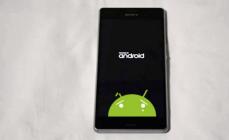Beginners and inexperienced users have a question: “How to set up the Internet on a tablet?” after purchasing it. After all, without connecting to the global web, it is impossible to take advantage of all the advantages that this device has. For these purposes, 3G or Wi-Fi are now most often used. Each of them has both advantages and disadvantages, which will also be discussed in this article.
3G
First, let's find out what is on the tablet in the networks of mobile operators. Not every similar device is equipped with such a module, and you need to look at the documentation and find out its presence or absence in the device. If you don’t have it, you will need to additionally purchase an external 3G modem that is supported by your mobile PC (this information is in the instruction manual). Then a SIM card is installed in it and it is connected to the tablet using an OTG cable. In the second case, when the device is equipped with a 3G module, it is enough to install it in the appropriate slot. All the previously listed manipulations must be performed only in the off state. Then we launch it. Next, after the download is complete, you should receive automatic settings from the operator. We accept and save them. If this does not happen, then you need to do it manually on the tablet. MTS, for example, in the “Applications / Settings / Wireless networks” section requires creating a new APN and setting the following parameters:
- Connection name: "MTS-Internet".
- MTS login and password.
- The APN should be as follows: “internet.mts.ru”.
Save the changes and reboot. We allow Internet connection in the top drop-down menu by clicking on the corresponding button. We activate the data service by calling 0890 (suitable for MTS subscribers, for other operators you need to clarify this information). After this, you can check the functionality of this service by launching a browser and going to the address “mail.ru”, for example. If everything is done correctly, this mail portal will open. Otherwise, call 0890 and find out the problem. An important nuance: your account balance must be positive.

WiFi
Now let's look at how Wi-Fi technology is based on a tablet. To begin, enable this adapter in the top drop-down menu by clicking on the corresponding button. Next, go to “Applications / Wi-Fi”. After launching this utility, we search for all available connection points. To do this, click the “Search” button and wait for the scanning to finish. Then, from the generated list, we select the network we are interested in and connect to it. If there is protection, you will need to enter a password. Close all windows and launch the browser. We enter the same mail portal “mail.ru” and check its functionality. This way you can set up the Internet on a Samsung tablet or any other manufacturer. It is important that it runs under the Android OS.

Conclusion
Within the framework of this material, the most common options for how to set up the Internet on a tablet were considered. The first one is 3G. It allows you to access the global web almost anywhere in the world. But at the same time its speed is low. Another disadvantage of this solution is the high tariffs of operators. The second method is Wi-Fi. Its speed, depending on the type of router used, can reach 300 Mbit/s. The second plus is the ability to connect to an unlimited tariff from the provider. But the main disadvantage of this solution is the small range of action, which is limited to a few tens of meters, at best. Therefore, 3G is well suited for frequent business trips, and Wi-Fi is the only option for home use.
Our Internet does not work on a tablet or phone. How to make it work? Here are a few common reasons that often cause failures.
Check if mobile data is enabled
This is the simplest moment. And although the reason is banal, the lack of inclusion of mobile data is one of the most common. It's easy to check this point:
If Android, then go to the menu, find the “Data transfer” item. We check that the “Mobile traffic” or “Mobile data” checkbox is activated.
Or even faster - call up the quick menu by swiping your finger across the screen from the area where we have the icon for the mobile network antenna, battery and clock. We make sure that the “Airplane Mode” item is disabled and the “Mobile Data” or simply “Data” item is enabled.
If we have iOS (iPad or iPhone). Go to settings, find the “Cellular data” item. On the right, the “Cellular Data” slider of the same name should be turned on.
Or easier - swipe your finger on the main screen from the bottom edge of the desktop up. Find the cellular antenna icon and check that it is activated.
Internet is connected but not working
We made sure that mobile data is turned on. Network - 3g, H, H+, 4g or LTE. That is, the network is good. But when we open the browser, an operator window appears with the message “No money” or something like that.
If we know for sure that the Internet has been paid for and we have a positive balance (by the way, we check the balance), then the issue may be in the browser page cache. That is, at some point in your browser a page of an operator like “no money” or “you need to pay” was opened. And your browser simply opens this page, since you simply minimized it. He has memorized this page and is showing it to you.
The solution is to manually type the address of a website in the address bar, for example, “google.ru”. If it doesn’t help, we simply try to reboot (completely turn off) the tablet or phone. You can also try opening a different browser.
Reboot
Rebooting (completely turning off and then turning on) your phone or tablet is a very useful tool. Many problems with gadgets can be solved by rebooting. Including connection problems.
The network disappears
Mobile Internet has its pros and cons. On the downside, the stability of the connection is influenced by many factors. For example, there is a building in front of your house that “blocks” the signal. The quality of the network can be affected by the thickness of the walls or how many people around you are online.
If your network suddenly disappears, then simply turn on “Airplane mode” for a few seconds. Your gadget will disconnect from the network and after turning off “Airplane Mode” it will re-acquire it. Or use the reboot tool (reboot the gadget).
Replacing a SIM card
If you have problems with the network for a long time and do not depend on your location, then the cause may be a faulty SIM card. You can make calls from it, the SIM can even provide internet, which is good at times, but it may be faulty. In this case, replacing the SIM card often helps.
It also makes sense to test the SIM card in another device.
In order to access the Internet through a SIM card of one of the MTS, Beeline or Megafon operators on an Android tablet, you can use one of four methods:
Use a 3G tablet - it already has a built-in SIM card slot.
It is most convenient, but the cost of a tablet with a built-in 3G module will be significantly higher.
In this case, setting up the Internet on your tablet via a SIM card will be very simple. To do this, just choose an operator with the most profitable and convenient tariff plan, purchase a SIM card that is also suitable for and insert it into the appropriate slot.
Purchase a USB modem and set up an Internet connection to the tablet.
If the tablet has a USB input, connect the modem to it; if there is no such port, use an OTG cable (adapter from micro-USB to USB). The advantage of the modem is that it can also be used on other devices (desktop computer, laptop), but the disadvantage is that this modem will get in the way, which is not very convenient, for example, on the road.
There will also be no problems setting up USB modems from the main operators MTS, Beeline and Megafon. The only subtlety is that the modem needs to be switched from the “modem + flash drive” state to the “modem only” state, otherwise the tablet will only recognize the flash drive. This is not difficult to do, and it is also easy, if necessary, to return this modem to the ability to use it as a flash drive.
First, you need to disable entering your PIN code. You can do this by connecting a USB modem to your computer. Then, using the special HyperTerminal utility, disable the flash drive function:
- Connect the modem to your computer and open Device Manager.
- In it, find the “Modems” category, open the properties of the USB modem.
- On the “Modem” tab, remember or write down the port number.
- Open HyperTerminal. Enter any name in the “Name” column. Select the recorded port from the drop-down list. Click "Ok".
- Open the “File” menu, select “Properties”. On the “Settings” tab, click on “ASCII Setup...”. In the window that appears, check the box next to “Echotypescharacterslocally”. Click “Ok” in all windows.
- A window will open and a cursor will appear. Enter the command “AT”, press the Enter button, wait for the response “OK”. Next, enter the command “AT^U2DIAG=0” and wait for “OK” again.
Then on the tablet, go to the network settings and check the boxes next to the “Data transfer” and “3G” items.
Use a 3G router to access the Internet via a SIM card.
This is a device with a SIM card, it receives a 3G signal and distributes the Internet via Wi-Fi. In addition to the tablet, you can connect any other device to it: computer, laptop, phone. It’s convenient because if the signal is poor, the router itself can be raised higher and closer to the window, and you can sit where it’s more convenient.
Connect the tablet via Wi-Fi to a 3G smartphone with the Internet.
In this case, the smartphone acts as a router - it receives a 3G signal and distributes Wi-Fi. To enable the router function, you need to find the “Wireless networks” item in the smartphone settings, go to the “Modem mode” item and activate the “Wi-Fi access point” item. Here you can set a password to access the network. A very energy-intensive option, the smartphone will quickly run out.
In any of the four methods, you may need to manually enter some settings:
Set up Internet from MTS:
- APN: internet.mts.ru
- Name: mts
- Password: mts
Internet settings from Beeline on the tablet:
- APN: internet.beeline.ru
- Name: beeline
- Password: beeline
Megaphone Internet settings for the tablet:
- APN: internet
- Username: gdata
- Password: gdata
First you will need to install a SIM card from your mobile operator, i.e. connect the device to the network. This card can be purchased at communication stores. The SIM card is installed in the appropriate slot in accordance with the instructions for use of the device. Many modern devices are equipped with micro-SIM slots, so before purchasing a card, check its format. If the device does not have a slot for a SIM card, it means that it does not support data transfer over a cellular channel and 3G setup on it is impossible.
Modern tablets automatically configure mobile Internet immediately after installing a SIM card.
To apply the changes, you will need to restart your tablet and then enable packet data mode. For Android devices, turning on 3G is done through the menu, which is called up by sliding the top panel of the system down with your finger. The mobile data channel can be configured through the menu item “Settings” - “Wireless network” - “Mobile communications”. From the list of available options, select the “Data transfer” mode. If necessary, turn off Wi-Fi to activate the operator's network. If you're using an iPad, 3G turns on automatically when you're not connected to Wi-Fi. You can disable this type of data transfer by going to the Settings menu on the iOS desktop.
Manual setting
If after installing the SIM card the Internet is still not available, check the modem settings specified in the system. On Android, go to the “Mobile Communications” - “Access Point” options again. Create a new access point and enter the Internet settings provided by your service provider. For iPad, this menu item is located in the “Settings” - “Cellular Data” - “APN Settings” section. After making the settings, make sure that the “Cellular Data” option is turned on.
To obtain the necessary settings, you can use the official website of the cellular company or call the operator’s customer service office to clarify the required parameters.
Reboot to apply the necessary settings and try to access the Internet using the built-in browser of your device. 3G setup is complete. If, after setting the parameters, the Internet still does not work, contact the operator’s support service to resolve the problem with the functioning of the data network.
To start using the Internet on your tablet, you just need to insert a SIM card from your mobile operator, or have an available Wi-Fi connection nearby. Setting up the Internet and debugging all the options is not at all difficult, following the instructions in this article. Please note that when you insert the SIM card into the device, it should reboot. If the tablet does not do this, perform a restart yourself.
How to set up mobile Internet on a tablet
To access traffic from a SIM card, make sure that you have activated the appropriate tariff from your telecom operator or purchased an unlimited Internet package. Otherwise, you will be charged according to the terms of your current tariff; the cost of non-Internet data plans is usually very high.
- go to the tablet settings through the tray. To do this, simply drag the screen with your finger from top to bottom and click the gear in the upper right corner of the tray;
- The tablet settings will open in front of you, find the line “Data usage” and click on it;
- check the box next to the words “Mobile data”;


- For detailed settings, immediately click the three lines in the upper right corner. You will see several fields: “Data in roaming” will block Internet traffic from the SIM card if you are outside your home region, because the service plan will increase without specially connected options from the operator; “Limit background data” will allow you to set a limit on traffic usage. For example, you have a tariff connected that provides an unlimited Internet option of 3 GB for a month. You set a limit of 3 GB through this line and your traffic will not exceed this limit, thus you will save money. The remaining criteria do not directly affect your mobile data transfer, these are only additional options;


- go to the “Advanced settings” tab in the list on the left. Click on the line “Mobile networks”;


- here you can configure your network in more detail if something goes wrong and it gets lost. Go to the “Network Mode” tab;


- Place a dot next to “GSM/WCDMA (automatic)”. This will allow the device to switch between network types on its own, depending on the situation;


- return to the menu and click on “Network Operators”, only if your operator is identified incorrectly. Click on the words “Search for networks” in the drop-down window;
- wait a few seconds to search;


- under the top two lines you will see all the operators that were found in this region. If you haven’t found yours, then perhaps your operator’s mobile towers simply aren’t in your location area.
After all the manipulations, your mobile data should work without interruption. If you still cannot set up mobile data transfer, contact your operator to get Internet settings, save the configuration on your tablet, and then perform this algorithm.


How to set up Wi-Fi Internet on a tablet
If there are available Wi-Fi networks near you or you know the password for any of them, then you can very quickly set up a connection via a wireless network:
- go back to the settings of your device, click on the Wi Fi tab;


- drag the slider until it turns green;
- in the field on the right you will see all the Wi-Fi networks that are nearby; if the lock next to the network is lit, this means that it has a password;


- click on the network for which you have the desired password and enter it in the window that appears;
- click “Connect”;


- You are now connected to the Wi-Fi wireless Internet network.


Sometimes, serious problems may arise with the drivers of this network if the Bluetooth / Wi-Fi adapter chip is damaged, or if there are failures in the device’s firmware. Then you will have to flash the tablet yourself or contact a service center.






